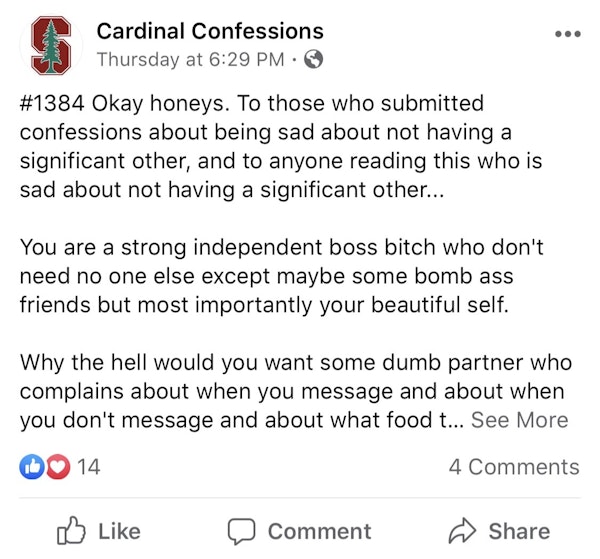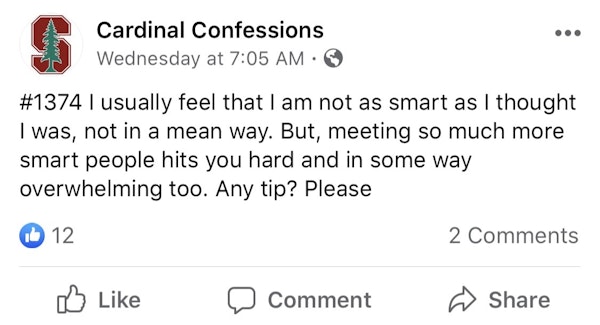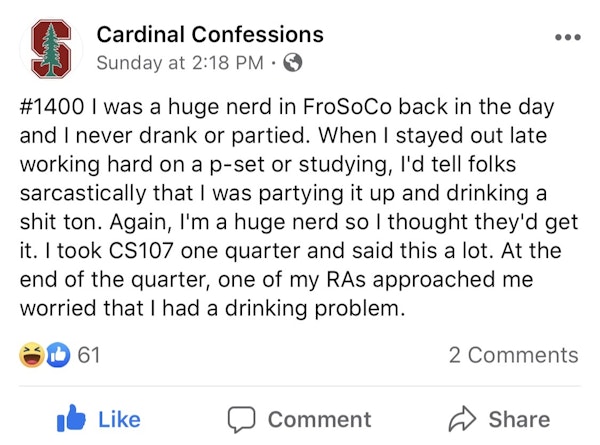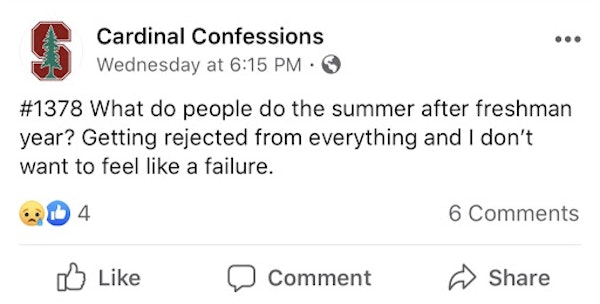Cardinal Confessions: a Reflection on Power Users, User Acquisition, and Virality
My first year at Stanford, through many late-night convos, I realized that most of my classmates experienced the notorious "duck syndrome:" pretending to be perfect outside but secretly struggling to keep up in reality.
People needed a safe space, like the late night convos I had, to express their true feelings, ask for help, and support others without feeling judged. An anonymous Facebook confessions site seemed like a great solution--easy to build/test and reducing the friction of attaching one's identity to their content.
A friend and I quickly pulled together a page and a Google form that would automatically post submissions. We marketed it around campus, putting flyers on doors and getting our classmates to post to social media. Despite our efforts, growth was nonexistent a few weeks in--only 50 people followed the page.
However, our group of friends continued posting multiple times a day--jokes, rants, crushes, and deep ponderings like the ones in the photos below. We were the product's power users--and our enthusiasm to create great content pulled in new users similar to us. Seeing the hilarious/deep/sensitive stories, other students began spreading word, and the page followers and postings began to spike.
The page became a hub for Stanford students to express their true realities, and it grew to over 2,000 followers and postings in a few months.
Learnings About Product
1. Find simple but effective solutions
We could've made an app, but a Facebook page was easy to set up and test our core hypothesis and gave us a way to utilize the platform's existing social graph.
2. Focus on great content and the target user vs growth tactics
Despite the initial lack of growth, I knew we found our target user (ourselves and our friends) and achieved PMF since they were engaged multiple times a day (~100% DAU/WAU) and near 100% retention.
I tested promoting--flyers, social media--but received few clicks. Rather, what attracted new users were the deep and thoughtful stories that our power users shared. The product was the content, and I've learned to let your product and enthusiastic first users do the talking.
3. Network effects
I was initially worried how the user growth would scale (fear that growth would be linear), but with an inherently viral product, every post would bring in 2 more users. I set the KPI to be num of posts per day, and user numbers continued to grow >15% every week.
4. Finding a specific niche and diving mile deep
Why did users like posting on Cardinal Confessions? Because it was the unique place to find and share stories about mental health, harassment, and academic struggles (70% of total content). There are a million other sites to find funny content and crushes. We chose a specific niche that other sites didn't cover and dived mile deep into that use case until we became to go-to for that.
5. Building culture and community
It's interesting to me that although an anonymous social page can be used for literally any purpose, 70% of our stories were about personal struggles and 30% were multiple paragraphs long.
Ultimately, I believe our initial thoughtful, lengthy stories by our power users set the precedent and culture for the page, which attracted similar users to them. This has taught me the importance of targeting the right user personas and being careful about the culture those early users set.
My first year at Stanford, through many late-night convos, I realized that most of my classmates experienced the notorious "duck syndrome:" pretending to be perfect outside but secretly struggling to keep up in reality.
People needed a safe space, like the late night convos I had, to express their true feelings, ask for help, and support others without feeling judged. An anonymous Facebook confessions site seemed like a great solution--easy to build/test and reducing the friction of attaching one's identity to their content.
A friend and I quickly pulled together a page and a Google form that would automatically post submissions. We marketed it around campus, putting flyers on doors and getting our classmates to post to social media. Despite our efforts, growth was nonexistent a few weeks in--only 50 people followed the page.
However, our group of friends continued posting multiple times a day--jokes, rants, crushes, and deep ponderings like the ones in the photos below. We were the product's power users--and our enthusiasm to create great content pulled in new users similar to us. Seeing the hilarious/deep/sensitive stories, other students began spreading word, and the page followers and postings began to spike.
The page became a hub for Stanford students to express their true realities, and it grew to over 2,000 followers and postings in a few months.
Learnings About Product
1. Find simple but effective solutions
We could've made an app, but a Facebook page was easy to set up and test our core hypothesis and gave us a way to utilize the platform's existing social graph.
2. Focus on great content and the target user vs growth tactics
Despite the initial lack of growth, I knew we found our target user (ourselves and our friends) and achieved PMF since they were engaged multiple times a day (~100% DAU/WAU) and near 100% retention.
I tested promoting--flyers, social media--but received few clicks. Rather, what attracted new users were the deep and thoughtful stories that our power users shared. The product was the content, and I've learned to let your product and enthusiastic first users do the talking.
3. Network effects
I was initially worried how the user growth would scale (fear that growth would be linear), but with an inherently viral product, every post would bring in 2 more users. I set the KPI to be num of posts per day, and user numbers continued to grow >15% every week.
4. Finding a specific niche and diving mile deep
Why did users like posting on Cardinal Confessions? Because it was the unique place to find and share stories about mental health, harassment, and academic struggles (70% of total content). There are a million other sites to find funny content and crushes. We chose a specific niche that other sites didn't cover and dived mile deep into that use case until we became to go-to for that.
5. Building culture and community
It's interesting to me that although an anonymous social page can be used for literally any purpose, 70% of our stories were about personal struggles and 30% were multiple paragraphs long.
Ultimately, I believe our initial thoughtful, lengthy stories by our power users set the precedent and culture for the page, which attracted similar users to them. This has taught me the importance of targeting the right user personas and being careful about the culture those early users set.









